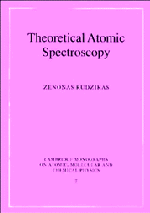Book contents
- Frontmatter
- Contents
- Preface
- Foreword to the Paperback Edition
- Introduction
- Part 1 Energy Spectrum of Many-electron Atom. Radiative and Autoionizing Transitions (Initial Formulas)
- Part 2 Foundations of the Angular Momentum Theory. Graphical Methods
- Part 3 Description of Complex Electronic Configurations
- Part 4 Second-quantization in the Theory of an Atom. Quasispin and Isospin
- Part 5 Matrix Elements of the Energy Operator
- Part 6 Electric and Magnetic Multipole Transitions
- Part 7 Calculation of Energy Spectra and Electronic Transitions in the Case of Complex Configurations
- Epilogue
- References
- Index
Introduction
Published online by Cambridge University Press: 21 September 2009
- Frontmatter
- Contents
- Preface
- Foreword to the Paperback Edition
- Introduction
- Part 1 Energy Spectrum of Many-electron Atom. Radiative and Autoionizing Transitions (Initial Formulas)
- Part 2 Foundations of the Angular Momentum Theory. Graphical Methods
- Part 3 Description of Complex Electronic Configurations
- Part 4 Second-quantization in the Theory of an Atom. Quasispin and Isospin
- Part 5 Matrix Elements of the Energy Operator
- Part 6 Electric and Magnetic Multipole Transitions
- Part 7 Calculation of Energy Spectra and Electronic Transitions in the Case of Complex Configurations
- Epilogue
- References
- Index
Summary
Atomic spectroscopy continues to be one of the most important branches of contemporary physics, and has a wealth of practical applications. Many domains of modern physics and other fields of science and technology utilize atomic spectroscopy. Modern atomic spectroscopy studies the structure and properties of all atoms of the Periodical Table, and ions of any ionization degree.
Spectra are fundamental characteristics of atoms and ions, the main source of information on their structure and properties. Diagnostics of both laboratory and astrophysical plasma is carried out, as a rule, on the basis of these spectra. Nowadays the possibilities of theoretical spectroscopy are much enlarged thanks to wide usage of powerful computing devices. This enables one to investigate fairly complicated mathematical models of the system under consideration and to obtain in this way results which are in close agreement with experimental measurements. Interest in spectroscopy has increased particularly in connection with the rise of non-atmospheric astrophysics and laser physics. New important applied problems have arisen: diagnostics of thermonuclear plasmas, creation of lasers generating in the X-ray region, identification of solar and stellar spectra, studies of Rydberg, ‘hollow’ atoms, etc. Due to the use of laser-produced plasmas, powerful thermonuclear equipments (Tokamaks), low inductance vacuum sparks, exploding wires, beam-foil spectroscopy, and other advanced ion sources and ion traps (such as EBIS, EBIT, ECR, etc.) there was discovered a new, extremely interesting and original world of very highly ionized atoms, their radiation being, as a rule, in the far ultraviolet and even the X-ray wavelengths region. The spectra due to the transitions between highly excited (Rydberg) levels are studied intensively.
- Type
- Chapter
- Information
- Theoretical Atomic Spectroscopy , pp. xxi - xxxPublisher: Cambridge University PressPrint publication year: 1997

